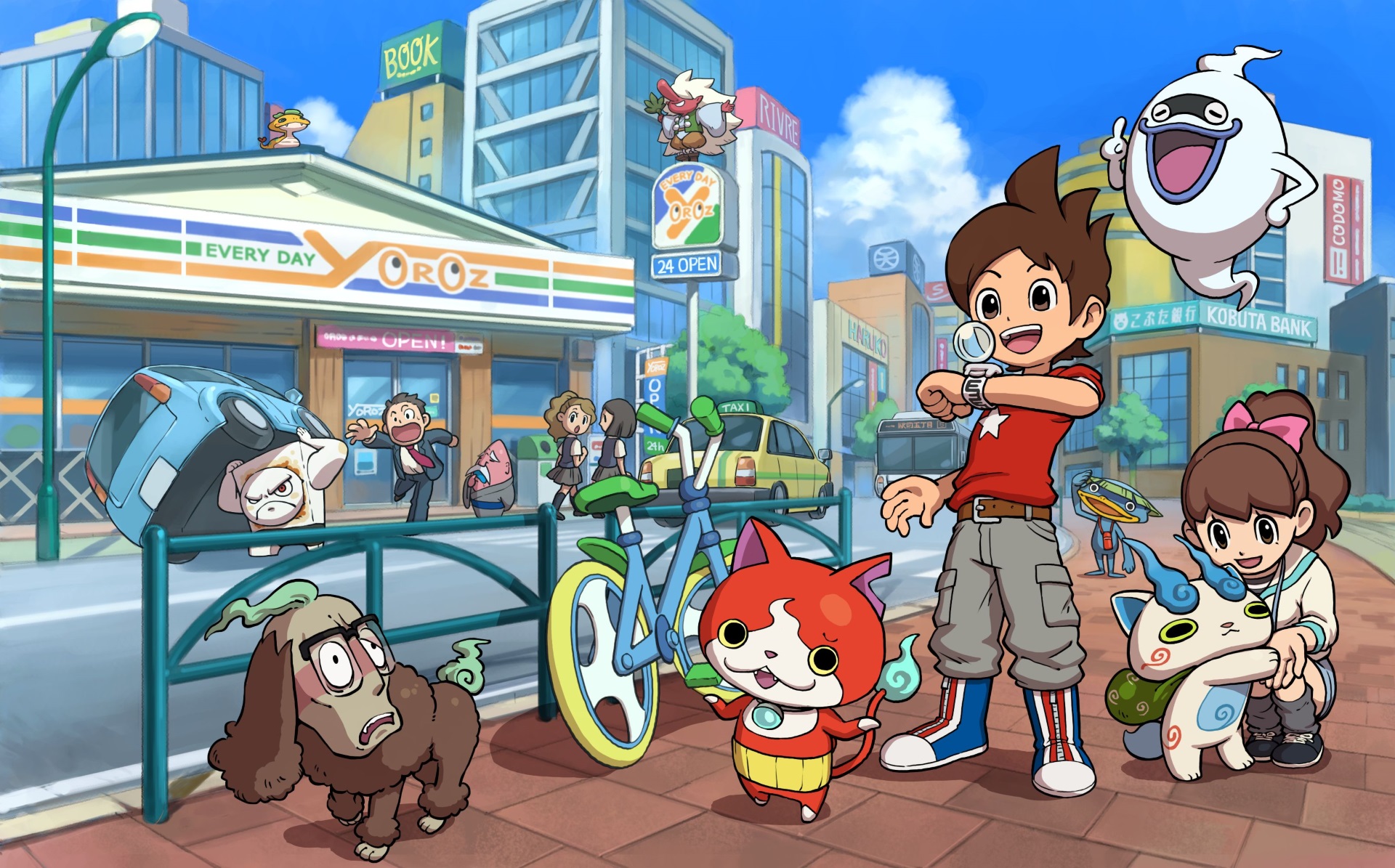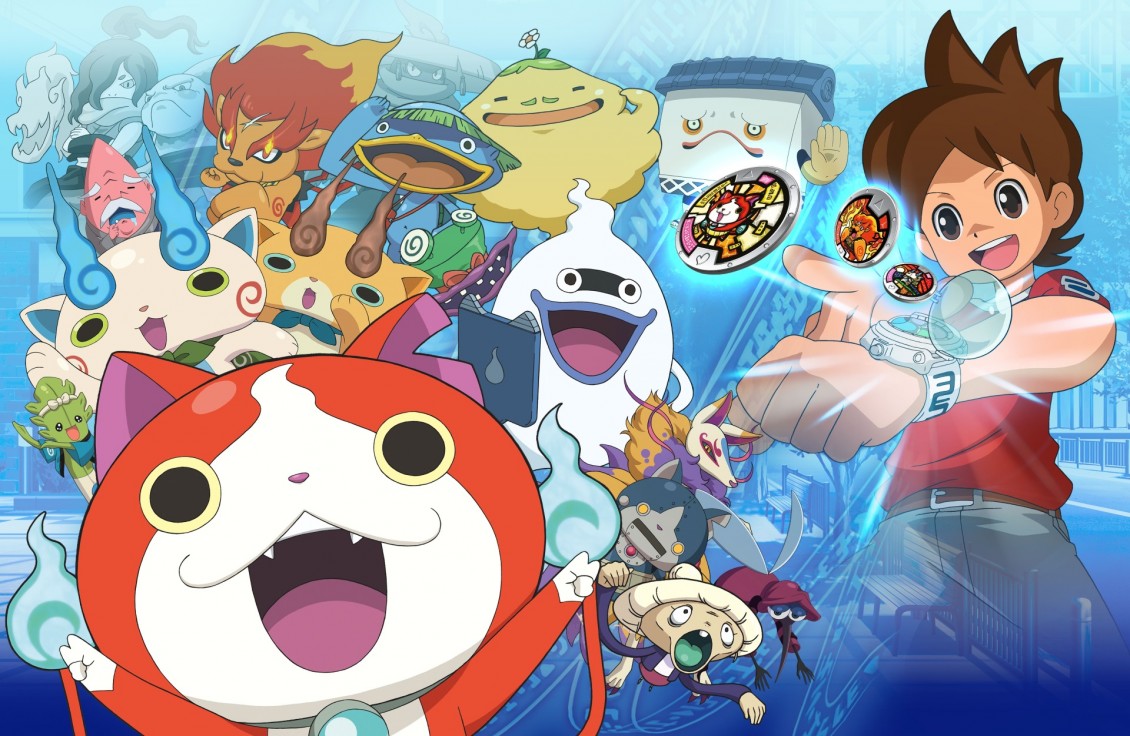It’s not often you’ll venture into the woods to catch bugs and venture back out into a town inhabited by troublesome spirits – all of this is thanks to a rather strange capsule machine placed under a sacred tree. Assuming the role of a young boy who finds himself embroiled in a mythical battle between the realms of human-kind and spirit-kind, Yo-Kai Watch has a simple enough premise but underneath all the whimsical charm is a complex RPG that courts both younger and older players.
After acquiring a colourful new watch (a Yo-Kai Watch; no less) and a ghostly butler by the name of Whisper, your character’s life is changed for good. Yo-Kai are spirits which feature in Japanese folklore, influencing the lives and behaviors of the humans around them; for better or worse. Most are hidden away under cars, in trees or around bodies of water and by using your Yo-Kai watch, you’re able to see and befriend them. Befriending them allows you to add them to your party and include them in battle, eventually leveling them high enough to evolve or fuse together, but we’ll get to that later.
The main plot line of Yo-Kai Watch is pretty simple, and is told over eleven chapters. It’s surprisingly devoid of focus until very late on, with random appearances of key characters throughout the chapters being about the only thing to encourage you on. Many of the quests feature morals which include caring for others, being a good friend, and so on. There are numerous elements within Yo-Kai Watch that appear to cater to a young audience, such as warning messages when you cross the street without waiting for the lights to go red, but Yo-Kai becomes far more complex when battles become involved.
 Similar to the Pokémon franchise, you’re able to equip six Yo-Kai in your watch for use in battle. Random encounters are non-existent, and to battle, instead you must seek out the secretive Yo-Kai using your watch, which can be a blessing and a curse. It removes the sometimes infuriating nature of random encounters, but minimises the chances of strengthening your party. This ultimately can lead to the need to grind before undertaking some bosses as you’re under-leveled. Before advancing with story missions, you’re also required to upgrade your Watch rank by battling specific Yo-Kai (grinding) which can really limit the flow of the narrative.
Similar to the Pokémon franchise, you’re able to equip six Yo-Kai in your watch for use in battle. Random encounters are non-existent, and to battle, instead you must seek out the secretive Yo-Kai using your watch, which can be a blessing and a curse. It removes the sometimes infuriating nature of random encounters, but minimises the chances of strengthening your party. This ultimately can lead to the need to grind before undertaking some bosses as you’re under-leveled. Before advancing with story missions, you’re also required to upgrade your Watch rank by battling specific Yo-Kai (grinding) which can really limit the flow of the narrative.
Despite this, battles are surprisingly interactive and are certainly more thrilling than your regular routine of always selecting the best move to hammer your opponent. More often than not, the battles are 3v3 with you being able to rotate your watch dial to switch out the Yo-Kai you want to use. This means that in most encounters, you’ll have to use all of your Yo-Kai in order to achieve victory as you switch out an attack-focused spirit with a healer in order to prevent fainting. This interactivity is exciting and adds a new dimension to combat, allowing for more creative reign on how you fight.
Using the lower touch screen, you’re able to charge up your Yo-Kai to unleash a Soultimate move: a more powerful attack which can have a variety of effects depending on the Yo-Kai’s type and role. This is done by performing a quick mini-game which ranges from using the stylus to spin the screen or tracing three linear patterns to power up. Yo-kai can also become inspirited, a sort of status effect which leaves them unable to perform their Soultimate burst and can slowly sap away their health or soul meter. To rid them of this, you are required to move them off the field to purify them, a process which is very similar to that of charging Soultimate moves. Having to constantly mix and match the Yo-Kai on the field can get very intense, especially during boss battles as damage is being dealt all around, fighters are being inspirited three at a time and you’re required to target specific areas. There’s so much going on at once that it’s hard to keep up, but that’s not a complaint. Because of this, the more difficult battles are complete white-knuckle rides and require your fullest attention to win, with boss encounters almost always lasting longer than ten minutes. It’s here that it feels less kid-friendly and more aimed at more mature gamers, as younger players may struggle with the endurance required for longer fights.
But the battle system won’t suit everyone. It can get very busy and confusing at times, especially when you’re being battered from all angles. Processes such as purifying inspirited Yo-Kai and using items take time and can eat into the precious seconds of breathing space you might catch once in a while. There are also a few elements of the system I completely ignored altogether as I found them incredibly hard to grasp. Whereas in Pokémon creature types follow the basic laws of nature (water beats fire, etc), Yo-Kai presents a rather muddled system of types such as Slippery, Charming, Brave, and Eerie. It’s never really explained what works well against each type or what the benefits are, despite it being stressed that using the right combinations is essential to victory. Some Yo-Kai are clearly fire-based while others are clearly water, but the vast majority is entirely ambiguous. I think the only thing I learned in the entire campaign of Yo-Kai was that Slippery fighters are less susceptible to becoming inspirited.
The locale of Springdale is wonderfully crafted and often reminiscent of Level-5’s previous works such as Ni No Kuni. There are various neighbourhoods to explore, ranging from traditional Blossom Heights to metropolitan Downtown Springdale, each of which have been beautifully designed and mirror the cultural quirks of modern day Japan. For a handheld game, the size of the world is astounding. A wide range of shops and buildings you can enter are dotted around and are a joy to explore. Also, hidden away behind some buildings are alleyways which can offer treasure, shortcuts and rare Yo-Kai. These inclusions make the world feel even bigger and bursting with content. An entire day-night cycle has also been implemented, which is a lovely touch and only adds to the immersion and charm of the city. Traversing between areas can be incredibly tedious, though, and fast travel is unlocked far too late.

The design of the Yo-Kai’s you encounter is not as memorable as I’d hoped, with the highlights being the mascots of the series (Whisper, Jibanyan and Komasan) which is probably the reason why they were selected to front the promotional materials. Some of the spirit names are usually a play on words, such as Manjimutt being a dog-like creature with the face of a middle-aged man or Negatibuzz, a humanoid mosquito that exudes negative energy. There are 236 Yo-Kai to befriend in total and in my 15+ hours with the game, I only befriended 29. This is not for want of trying, but many Yo-Kai are incredibly hard to please and get on side. To increase you chances, you’re advised to feed them their favourite food, but unless you use a guide there’s no way to know which delicacy pleases them most without going through almost every piece of grub in your inventory. Even basic Yo-Kai such as Noway were virtually impossible to befriend, even after feeding him his beloved cup ramen. Not only that, but Yo-Kai aren’t guaranteed to spawn in their regular locations so often times I had to leave the area and return to trigger an encounter with the spirit I was searching for. It doesn’t help that some Yo-Kai are required to complete side quests. Eventually I gave up trying to capture wild Yo-Kai and stuck with leveling up those that join you voluntarily during story missions. Yo-Kai Watch misses the mark here, and there is no doubt that you’ll be left fizzing as an elusive spirit slips through your fingers for the 800th time.
Evolution takes more of a backseat, with only a small number of spirits evolving once they reach a certain level. I didn’t even know this was a feature until by Walkappa began evolving randomly. In addition, you’re able to fuse Yo-Kai together to create some wacky party members, such as blending Jibanyan and Roughraff together to make the spunky Baddinyan. The selection of fusible Yo-Kai is quite limited, but it is an interesting addition nonetheless.
The fun doesn’t have to stop after the credits roll, either. Once all the story missions have been completed, you’re able to freely explore the town and fulfill the huge range of side quests and favours that exist across the neighbourhoods. Some of these will be available between story missions and I’d almost certainly recommend finishing a fair chunk of them throughout the main campaign to ensure you’re not under-leveled. The majority of them offer great rewards, including enormous XP and rare items so they’re certainly worth your time. A few of the missions can be quite tedious and will involve going back and forth between three or four people, but generally the payoff is worth your effort.
Despite some missteps, Yo-Kai Watch is a brilliant role-playing title that is bursting with content and coated in charm. With an inventive and interactive battle system, combat feels fresher than other titles that have come before it. The town of Springdale is enormous, and the list of side quests and favours is even bigger, so there’s little chance you’ll run out of things to do. What appears to be simple on the surface is actually a complex but well thought out RPG, one that can appeal to both younger players in terms of adorable characters and moral-heavy story as well as a more mature audience in terms of the intense battle system. I’ll take ten Jibanyan plushies to go, please.
Support us by purchasing via these links:
Enormous world.
Inventive battle system.
Plenty of content.
Some Yo-Kai are adorable.
Aspects of combat are ambiguous.
Story is a bit on the short side.
Befriending Yo-Kai can be a nightmare.
Yo-Kai Watch is a charming and sprawling RPG, one that appeals to a younger audience with its adorable characters and moral-heavy story, but also to mature players with its intense and complex battle system.


